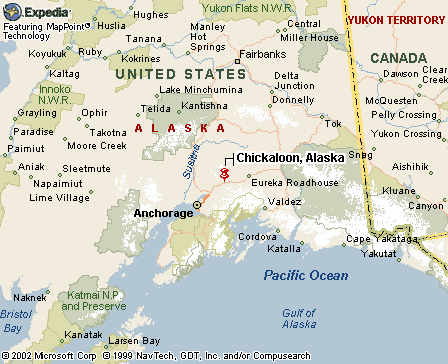|
|
Canku Ota |
|
|
(Many Paths) |
||
|
An Online Newsletter Celebrating Native America |
||
|
October 5, 2002 - Issue 71 |
||
|
|
||
|
Valley Visionary |
||
|
by Alberto Enriquez Anchorage
Daily News
|
||
|
|
 A
28-year-old expectant mother from Chickaloon -- the small village north
of Palmer just off the Glenn Highway -- has been recognized as a "young
visionary" by a national magazine. A
28-year-old expectant mother from Chickaloon -- the small village north
of Palmer just off the Glenn Highway -- has been recognized as a "young
visionary" by a national magazine.
"Did you know that the blue stuff in toilet bowl deodorizers is the latest chemical to turn up in human breast milk?" Native activist Shawna Larson asks, explaining her passion for work on environmental issues and tribal sovereignty. As distasteful as the thought may be, Larson hastens to add that she will, of course, breast-feed her baby when it comes. Mother's milk is still best. Her point is to keep it that way. Better that people should ask just how fresh a toilet really needs to be before unleashing extremely long-lived chemicals that can pop up anywhere in the food chain, from penguins in Antarctica to polar bears on the North Slope. Larson was recognized for her efforts on behalf of such causes in the October issue of Utne Reader, a bimonthly magazine often called "the Reader's Digest of the alternative press." Utne Reader senior editor Karen Olson said the magazine staff sifted through 170 nominees nationwide before settling on "30 under 30" young visionaries. She said the magazine decided to honor younger activists after the success of a 1995 issue heralding "100 Visionaries," which proved extremely popular with its readers. "We were looking for strong activists who are moving and shaking things the most and whose ideas offer hope for the future," Olson said. "Shawna is doing work on such an international level with her home in mind. Becoming involved that young on international treaties is not that common." In the past few years, working on issues ranging from persistent organic pollutants to tribal sovereignty, Larson has traveled as far as South Africa and Switzerland, with frequent trips to Washington, D.C. Now in her seventh month of pregnancy, Larson hasn't slowed down. In Montana for a meeting of the International Indian Treaty last week, she expected to return home Sunday only to fly out again Tuesday for a meeting with Alaska Sens. Ted Stevens and Frank Murkowski on the implementation of the Persistent Organic Pollutants treaty. "There's some other great trips coming up next month," Larson said by phone from Billings, Montana. "But I've already told them at the office that I'm going to have to stay home by then." Home, but busy nonetheless. Larson is the youngest member of the Chickaloon Traditional Village Council. She works as the community outreach coordinator for Alaska Community Action on Toxics -- ACAT -- and for the Indigenous Environmental Network. ACAT director Pamela Miller said Larson had worked tirelessly on persistent toxins, traveling extensively throughout Alaska and gathering more than 50 tribal resolutions to be presented to the Johannesburg conference on Persistent Organic Pollutants in December 2000. Larson said the POPs treaty is a particular focus for her because of its impact on the environment, on tribal subsistence foods -- and on mother's milk. The treaty bans some particularly noxious chemicals that break down very slowly, including DDT, dioxins and polychlorinated biphenols, or PCBs. It was signed by more than 100 nations at an international conference in Stockholm in late May. Studies in Canada have shown that game animals in some tribal subsistence areas are contaminated beyond levels considered safe for human consumption. No comprehensive study has been done of Alaska game, Larson says, and such limited studies as have been done may contain flawed assumptions because scientists failed to consult with tribal members. A Cook Inlet study, for example, found that PCBs, dioxin and cadmium in fish did not exceed safe limits according to the Environmental Protection Agency. "But they used the wrong consumption rates," Larson says. "Tribal members estimated that they might have 12 to 15 fish meals a week. The EPA assumed three meals a week." Utne Reader's Olson said Larson's dedication in bringing such perspectives to the table and in advocating the "Precautionary Principle" led to her selection. The Precautionary Principle states: "Whatever we do, we shouldn't do it until we know it won't do any harm." Larson has a dedication to that principle as fundamental as, well, mother's milk. ACAT's Miller, for one, thinks that dedication amply justifies the Utne Reader honor. "She's inspiring, very eloquent, and she certainly deserves the recognition," Miller said.
|
|
|
||
|
|
||
| Canku Ota is a free Newsletter celebrating Native America, its traditions and accomplishments . We do not provide subscriber or visitor names to anyone. Some articles presented in Canku Ota may contain copyright material. We have received appropriate permissions for republishing any articles. Material appearing here is distributed without profit or monetary gain to those who have expressed an interest. This is in accordance with Title 17 U.S.C. section 107. | ||
|
Canku Ota is a copyright © 2000, 2001, 2002 of Vicki Lockard and Paul Barry. |
||
 |
 |
|
|
The "Canku Ota - A Newsletter Celebrating Native America" web site and its design is the |
||
|
Copyright © 1999, 2000, 2001, 2002 of Paul C. Barry. |
||
|
All Rights Reserved. |
||
